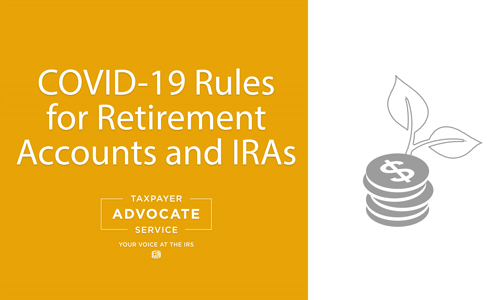
This tax tip simplifies available options for certain taxpayers that may need to withdraw money from existing retirement plans or IRAs to get cash or who may want to opt-out of the normally required retirement distribution payment, which may reduce additional taxes. Before you attempt any of these options as outlined, we encourage you to review the complete guidelines and rules for each situation and, when possible, consult a financial planning or retirement specialist first.
Option 1: Tax relief for retirement plan and IRA distributions
In certain circumstances, you may be eligible for special tax treatment for coronavirus-related distributions from traditional IRAs or retirement plan accounts.
To be eligible for relief, an individual must be a qualified individual, who is someone:
- Who is diagnosed, or whose spouse or dependent is diagnosed, with the virus SARS-CoV-2 or the coronavirus disease 2019 (collectively, “COVID-19”) by a test approved by the Centers for Disease Control and Prevention (including a test authorized under the Federal Food, Drug, and Cosmetic Act); or
- Who experiences adverse financial consequences as a result of the individual, the individual’s spouse, or a member of the individual’s household (that is, someone who shares the individual’s principal residence):
- being quarantined, being furloughed or laid off, or having work hours reduced due to COVID-19;
- being unable to work due to lack of childcare due to COVID-19;
- closing or reducing hours of a business that they own or operate due to COVID-19;
- having pay or self-employment income reduced due to COVID-19; or
- having a job offer rescinded or start date for a job delayed due to COVID-19.
Allowable withdrawal amount: If you are a qualified individual, you can get special tax treatment on distributions of up to $100,000 from your IRAs or retirement plan accounts from January 1, 2020 through December 30, 2020.
These coronavirus-related distributions:
- are not subject to the 10% additional tax on early distributions that would otherwise apply to most distributions before reaching age 59½;
- are not subject to any withholding requirement;
- may be included in income over a three-year period; and/or
- may be repaid within three years, if eligible for tax-free rollover treatment.
See IRS’s Relief for taxpayers affected by COVID-19 who take distributions or loans from retirement plans news release, Notice 2020-50 (PDF) or the More IRS Resources section listed below for more information and official guidance.
Option 2: You may be eligible for special rules for plan loans
Qualified individuals may also, until Sept. 22, 2020, be able to borrow as much as $100,000 (up from $50,000) from a workplace retirement plan, if their plan allows. Loans are not available from an IRA.
For eligible individuals, plan administrators can suspend, for up to one year, plan loan repayments due on or after March 27, 2020, and before January 1, 2021, although at least originally scheduled 2021 loan repayments must resume in January 2021. A suspended loan is subject to interest during the suspension period, and the term of the loan may be extended up to one year.
Taxpayers should check with their plan administrator to see if their plan offers these expanded loan options and for more details about these options.
Option 3: You may not be required to take Minimum Required Distributions (RMD)
Seniors and retirees may not be aware that the CARES Act waives the Minimum Required Distribution (RMD) during 2020 for IRAs and retirement plans, including beneficiaries with inherited accounts. You are included in this waiver if you turned age 70 ½ in 2019 and took your first RMD in 2020.
Since the RMD rule is suspended, RMDs taken in 2020 are considered eligible for rollover. Therefore, you can rollover RMDs to another different IRA, qualified retirement plan, or you can return it to the original IRA or qualified retirement plan (if that qualified retirement plan receives rollovers).
Notice 2020-51 (PDF) provides that if you received an RMD in 2020 before July 2, you have until Aug. 31, 2020 to roll over the amount or return the distribution to your account or other qualified plan. Otherwise the regular 60-day rollover period applies.
IRS Notice 2020-51 (PDF) also provides that if you received a distribution from an IRA and repay the amount to that IRA by August 31, 2020, the one rollover per 12-month period limitation and the restriction on rollovers to inherited IRAs do not apply to this repayment.
See IRS’s: Seniors, retirees not required to take distributions from retirement accounts this year under new law news release or the More IRS Resources section below for more information and official guidance.
More IRS Resources
- IRS: New law provides relief for eligible taxpayers who need funds from IRAs and other retirement plans
- Coronavirus-related relief for retirement plans and IRAs questions and answers
- Publication 590-A, Contributions to Individual Retirement Arrangements
- Publication 590-B, Distributions from Individual Retirement Arrangements
- Contribution limits
- Required minimum distributions (RMD)
- Hardship, early withdrawals, loans
- Rollovers and conversions
- Roth IRAs
- Tax Information for Retirement Plans
Follow the Taxpayer Advocate Service across social media: Twitter, Facebook, LinkedIn and YouTube.
Source: taxpayeradvocate.irs.gov

Leave a Reply